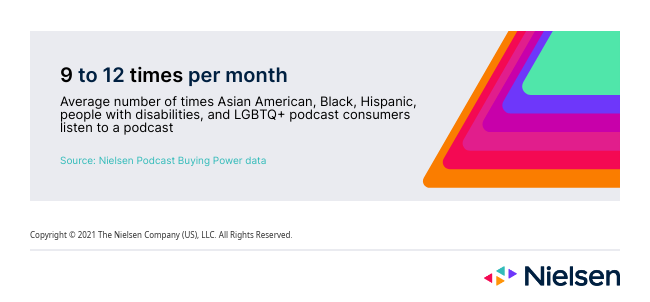Share brand ownership by investing in content that resonates with your audience – Nielsen
By Adam
Across all media, consumers are looking for consistency and credibility from the brands they engage with—not just in the products or services they offer, but in what they say and do.
Inclusion has become top of mind across the media industry, and it’s new terrain for many brands to navigate. Effective brands don’t just exist. TellConsumers are shown how they champion equity. But they also show their commitment by Taking action. As our population grows and personalization becomes more important, brands will need embrace inclusion by sharing ownership of consumers.
Representation matters to every identity group—male or female, Black or White, young or old. While mass media may sometimes be discounted in its ability to deliver personalized messaging, it’s still key to an effective long-term marketing strategy. Many identity groups are still not represented on-screen. Women, for example, make up more than half the U.S. citizen population, but they are far less visible on-screen than men (38% to 62%). Certain segments of women, especially those over 50, are severely underrepresented on screen. Women over 50 years old are 60% less likely that they will see themselves in programming.
Representation shouldn’t only be a focus on-screen, but also a focus in advertising. In regards to advertising, brands trying to reach underrepresented identity groups such as women—particularly those over 50—have a true opportunity to seize. This group spent nearly $800million last year across 25 CPG categories, as compared to $608 million for women aged 18-34 and $680million for women aged 35-49. SME found that consumers are more willing to buy products from brands that include someone from their identity group. Therefore, inclusion is essential to effective ad spend.
Diverse audiences want to see on-screen representations that reflect who they are as individuals. SME conducted a May 2021 survey and found that 49.7% of 18-24-year-olds, 51.2% and 25% of 25-34-year olds are more likely than others to engage with content that features someone from their identity group. In this way, people from underrepresented groups are moving to platforms with more representative content.
The 18.8% Hispanic population in the United States contributes more to the total population growth than any other segment. Hispanics make up 5.5% of TV’s screen share, while 10.1% of SVOD content’s screen share is for them. Although that’s just over half of their representation in the population, Hispanic viewers have taken note—particularly younger generations. 40% of the 15 most watched SVOD programs among Latinos 18-34 had strong or fair representation, compared to only 13% among Hispanics 35-plus.
Whether you’re trying to share your brand with women over 50, Hispanics or another underrepresented identity group, marketers have an enormous opportunity to capitalize if they understand where audiences are engaging and also take action to increase representation for diverse audiences.
While the primary challenge lies in creating messaging that looks like the audience it’s projected to, it’s equally important for brands to be mindful of how a message will be received, and adjust it to ensure it resonates. Unfortunately, when an underrepresented identity group does see itself represented in …read more
Source:: Social Media Explorer





